|
|
|
CONTACT US
Click Here! |
| This site is best viewed with a screen resolution of 800 X 600 at high colour settings |
|
Flask list
Acacallis-Ancistrochilus Angraecum-Aspasia Barkeria-Broughtonia Bulbophyllum Capanemia-Catasetum Cattleya Cattleyopsis-Cycnoch, Cymbidium-Cyrtorchis Dendrobium-Dossinia Encyclia-Eulophiella Galeandra-Kalopternix Laelia-Lycaste Macodes-Nephalaphyll, Odontogloss,-Oncidium Paphiopedilum-Psychilis Rangaeris-Stenocoryne Tainia-Zygopetalum |
|
Plant list
Acampe-Bulbophyllum Cattleya-Dossinia Encyclia-Promeaea Renanthera-Vanda |

BP SPECIES NEWSLETTER APRIL 2002July00 Aug Sept Oct Nov Dec January01 Feb Mar April MayJune July August September October November December January02 February March 
Photos in this issue. Graphorchis scripta (above),Sobennikoffia humbertiana, Pterostylis ophioglossa var Collina, Pterostylis Baptsistii, Dendrobium ruppianum (epiphytic) Dendrobium ruppianum (lithophytic).Do you know any orchid growers who may like to receive this newsletter? Why not forward this email to them now!A b&w printed copy of this Newsletter can be mailed each month if you send 12 Australian stamps or 12 International reply coupons to Burleigh Park Orchid Nursery, 54 Hammond Way, Thuringowa, Australia 4815.Items in this newsletter may be reproduced provided source acknowledged.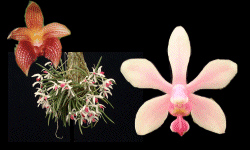
We commend "Orchids Online Web Design" for the excellent work on our web site and this Newsletter.Have a look now at some of the 550 new orchid photos pages just up at Steve's website at Orchids OnlineA. What's New in flask.
Photo: right Graphorchis scripta. The Madagascan equivalent of the South American Catasetums is grown as a deciduous plant, a complete dry rest in winter and a repot for spring into a rich media. When the new leads appear, apply lots of water and fertiliser. A small pot or basket and warm to intermediate conditions. (In winter, the dry pseudobulbs can be stored out of the cold until spring.) Paraphalaenopsis serpentilingua. This terete leafed warm growing Phalaenopsis type has white and red marked flowers. See December Newsletter for Paraphalaenopsis culture and descriptions. Sarcanthus pachyphyllus. A Philippines species that was at one time exported from there as Aerides pachyphyllus. A remarkable, attractive plant with thick curved leaves and a panicle of a multitude of small whiite flowers, lip pink purple. Best grown in a small basket in a well drained media, warm to intermediate conditions and plenty of sunlight. B. What's ready to replate NOW.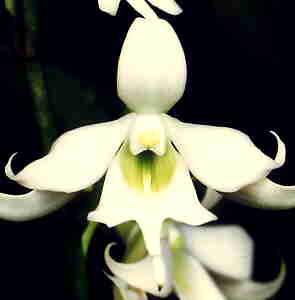
Oncidium stramineum, A Mexicam "mule ear leaf" that grows well on a slab or in a small pot or basket. The flowers are waxy straw coloured, fragrant. Intermediate grower, grow somewhat shady and in the cooler months reduce watering. Paphinia cristata, A very showy small grower that will exist happily in a small pot or basket in a media that will stay damp but not wet.. Intermediate grower, needs shade and when not in active growth, keep on the dry side, but do not allow to dry completely. Flowers to 7 cm, red with silver stripes. Plectrelminthus caudatus. An African species with large green and tan spurred flowers. A small basket is best, must have excellent air movement and a shady spot.The media needs to be coarse and well drained. C. What's new in Plants.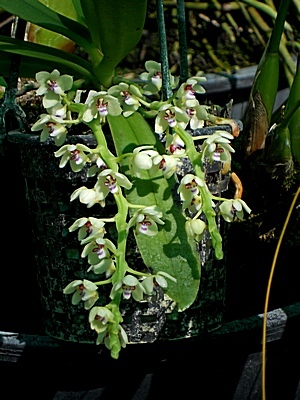
Aerides krabiense. Another small growing species, these have developed into flowering size plants in slotted 4" pots. Best grown warm to intermediate, in a well drained media in a basket or slotted pot. Sunlight much as for Dendrobiums etc. Dendrobium clavator. A species from S E Asia with fleshy, needle like leaves and attractive cream yellow flowers borne enmasse. The flowers have red purple marking on the labellum. Grows best on a mount or in a small well drained pot or basket. Flowering size plants well established on cork. Dendrobium bigibbum var superbum Alba. This is the Australian Phalaenanthe Dendrobium, well shaped flowers on an arching spike, pure white. Flowering size plants growing well in a small well drained basket. TOP D. Culture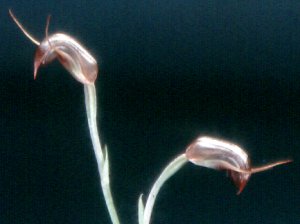
The flowers were neat, red with broad silver stripes, Pterostylis ophioglossa var Collina as I knew it then. A charming species. No doubt someone has changed its name for some reason by now. 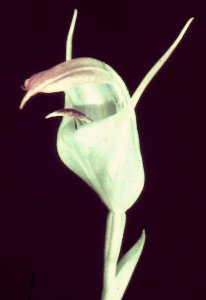
He was right, there along the road in the rough barked trees were lots of Eria queenslandica, and further along, in the large casuarinas, Cymbidium madidum and Dendrobium fusiforme ( then renamed Dend ruppianum, but it got changed again, it's named now after Mr Jones!!!). Photos below of Dend. ruppianum, epiphytic and lithophytic. The orchids were abundant in the trees, but unfotunately over the years have proved too tempting to collectors, and now the only remaining plants are high in the tree tops. 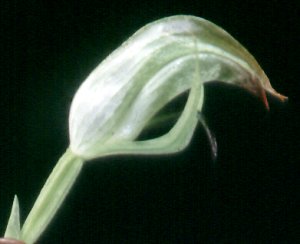
Having received requests from overseas for seed of Australian terrestrials, I asked a friend in Herberton, North Queensland to collect a couple of plants and pods of Pterostylis Baptistii from around his barbecue area, where it grew naturally. He did, and in the process sent down plants with pods and tubers, a few plants minus their tubers, and tubers minus their plants. 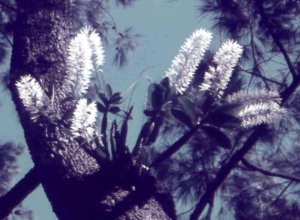
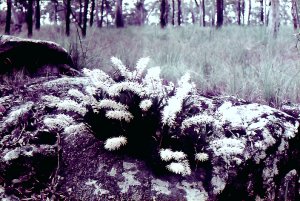
E. Did you know ?IMPORTANT NOTE for USA importers.USDA has, from January 2002, begun to enforce the requirement for a Phytosanitary Certificate for all plant and plant material imports. This is not a new regulation, but the implementation of a rule that has previously not been enforced. ALL FLASKS imported into USA will now require a Phytosanitary Certificate. Burleigh Park does provide this Phytosanitary Certificate at cost. Flasks are still CITES exempt. Trade in Seed of CITES listed species.
F. Humour.A woman walked into the kitchen to find her husband stalking around with a fly swatter."What are you doing?" she asked. "Hunting Flies" He responded. "Oh!, Killing any?" she asked. "Yep, three males, two females", he replied. Intrigued, she asked. "How can you tell?" He responded, "Three were on a beer can; two were on the phone." Men are like fine grapes. They need to be stomped on by women, kept in the dark and matured until such time as they are fit to have dinner with. As Ogden Nash observed, a successful marriage is one of incompatability. He has income, she is pattable. He sat down next to the man at the bar and in a rich Irish brogue, ordered a Guiness. His neighbour said, “Begorra, you’re from Ireland, so am I, from county Cork” “What a coincidence, so am I from county Cork, the village of Dumfry.” replied this new found friend. The other exclaimed, “ Dumfry, begorra, and I went to the Prep school in Dumfry.” The other said, “ What a an amazing thing, so did I go to that same school.” At that, the bar tender leaned over and said to his co-worker, “Looks like we are in for a night of it, the Murphy twins are drunk again.” G. Auctions.Orchids Online AuctionsUse this FREE orchid auction service to sell your spare plants and orchid books or have a look at the offerings from other orchid enthusiasts on the net. This orchid auction service has categories to list species orchids and hybrids, subcategorized into plants, flasks, specimen plants and collections. You can also buy or sell orchid or plant books, place wanted ads or your own classifieds...FREE! NOTE: Nurseries and businesses are more than welcome! H. A special note on flasking orchids.Due to the need for a filtered air vent on flasks to allow exchange of gasses, a reliable air filter medium is needed.Non absorbant cotton wool allows gas exchange but does not absorb moisture. Thus the air filter will stay dry and prevent the growth of fungus thru the filter, a common problem with ordinary cotton wool which gets wet, goes mouldy and allows the mould to grow thru the filter to contaminate the flask. Non Absorbant Cottonwool NOW AVAILABLE in 375 gram rolls, contact us NOW. |
Designed and maintained by
Orchids Online Web Design
© All rights reserved.